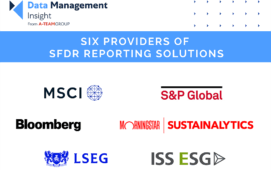
Finastra has lent its FinTech expertise and capabilities to an initiative that’s building a model to help banks boost their resilience to climate risks.
The London-based company has devised an interface that enables financial institutions, regulators and the public to access the Climate-Extended Risk Model (CERM) risk framework. Users, by their participation, also contribute ideas and data to further develop the model with the aim that it will become an industry standard for calculating the physical and transition risks to which banks’ loans and other assets are exposed.
“The sandbox is a playground for banks and also regulators to start looking into what it means to manage climate risk, what it means for their portfolio, how to model the transition of their portfolios and how to have a greener lending book,” Chirine BenZaied-Bourgerie, head of innovation at Finastra, told ESG Insight.
The initiative is helping to meet growing demand for climate-risk tools as investors and regulators recognise the importance of calculating the vulnerability of assets and investee companies to increasingly violent weather events, floods and other global warming-related natural disasters. It also comes as insurers build such risks into their policies.
CERM is a a mathematical risk model being built by non-profit Green RWA in conjunction with Professor Josselin Garnier from the Ecole Polytechnique in Paris. The ultimate plan is to produce an industry standard in climate and transition risk that can be incorporated into banks’ own risk-management systems and regulations, such as the next iteration of Basel.
Finastra has enabled access to a simplified version of the model so that banks can start using it now and help boost its capabilities.
“With CERM we are helping the market, the banks and regulator to define the proper climate risk methodology, to facilitate the transition of the funding capacity of banks towards a greener economy,” Green RWA’s Jean-Baptiste Gaudemet, fintech executive and co-founder of Green RWA, told ESG Insight.
Close Fit
Gaudemet said Finastra closely fits with the aims of CERM because the company already has expertise in providing risk management solutions to banks. The company also provides software and marketplaces to lenders, including its Loan IQ platform that facilitates the calculation of risk and performance premia – including those linked to ESG – on credit products.
Green RWA is in contact with global organisations in the development of CERM, including the International Monetary Fund, European Central Bank and the Federal Reserve. It’s also enlisted the help of data providers to help in calibrating the model. That’s going to be vital to making the project work, reflecting the findings of an UN Environment Programme’s Finance Initiative (UNEP-FI) report this year that said the weak link in climate risk modelling is data.
“It’s good to have a model that makes sense mathematically and reflects structural risk, but to have good outputs you need good inputs and that’s how you are able to collect the data to calibrate the exposure of your portfolio to physical risk and transition risk,” Gaudemet told ESG Insight. “That’s something that is very, very important, but very, very difficult to do and so we are collaborating as well with data providers.”
Growing Demand
Fintech and data providers including Morningstar’s Sustainalytics, Bloomberg, Intercontinental Exchange and MSCI offer clients tools to work out their climate-linked risk exposures. UNEP FI’s Climate Risk and Taskforce on Climate-related Financial Disclosures (TCFD) Programme created a Climate Risk Tool Dashboard to help financial institutions navigate “the ever-evolving climate risk tool universe”.
Such products have been made possible by the development of better predictive technology and they been partly driven by the increasingly apparent impact of climate change in the form of dangerous hurricanes and damaging floods as well as pulverising summer heat and frigid winters that have closed industries.
“Traditionally risk assessment tools have calculated probability on past data, but with climate change that’s impossible, because every year things have a tendency to get worse with the accumulation of greenhouse gas in the atmosphere,” said Gaudemet. “We have the tools now to look forward in the long term, but banks just aren’t used to using them and they also don’t have experience with the data they’ll need.
“That’s why it’s important to have an industry standard, like that which we are building.”
Subscribe to our newsletter




